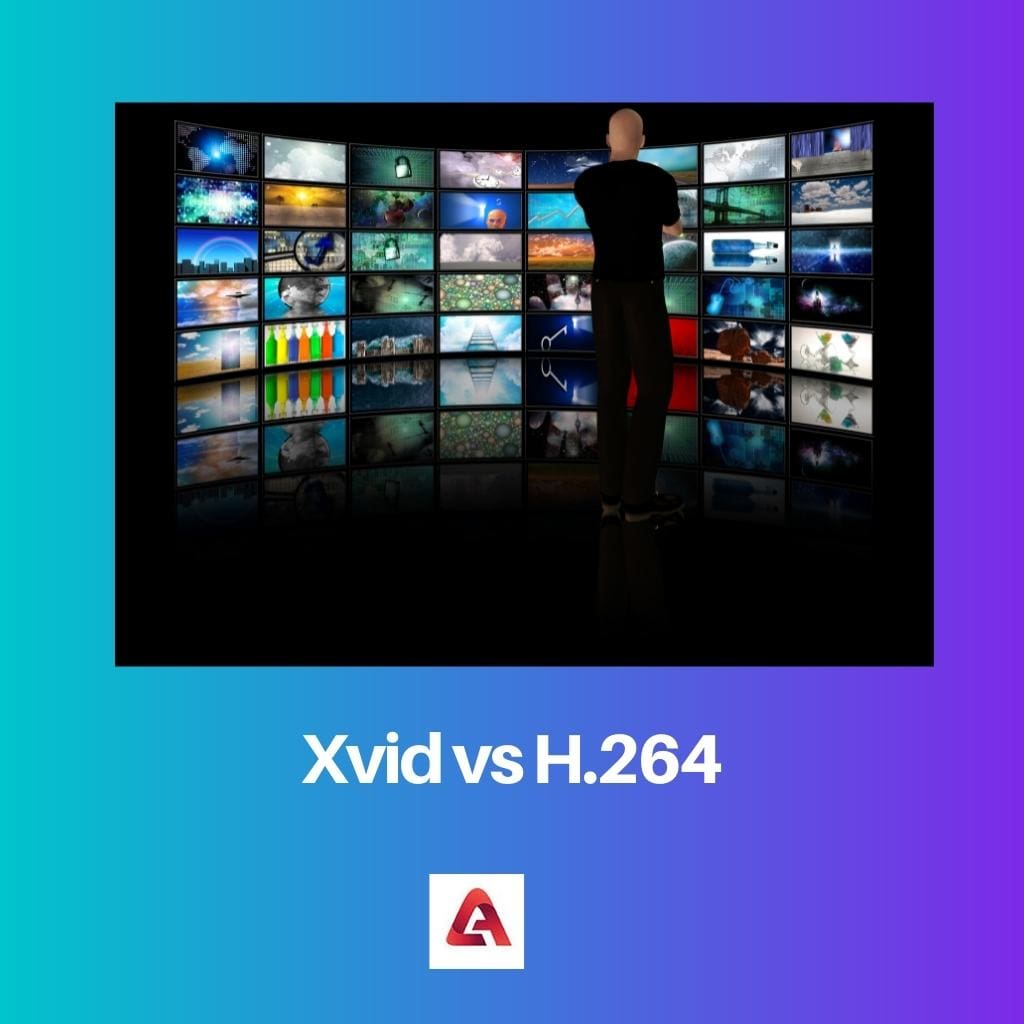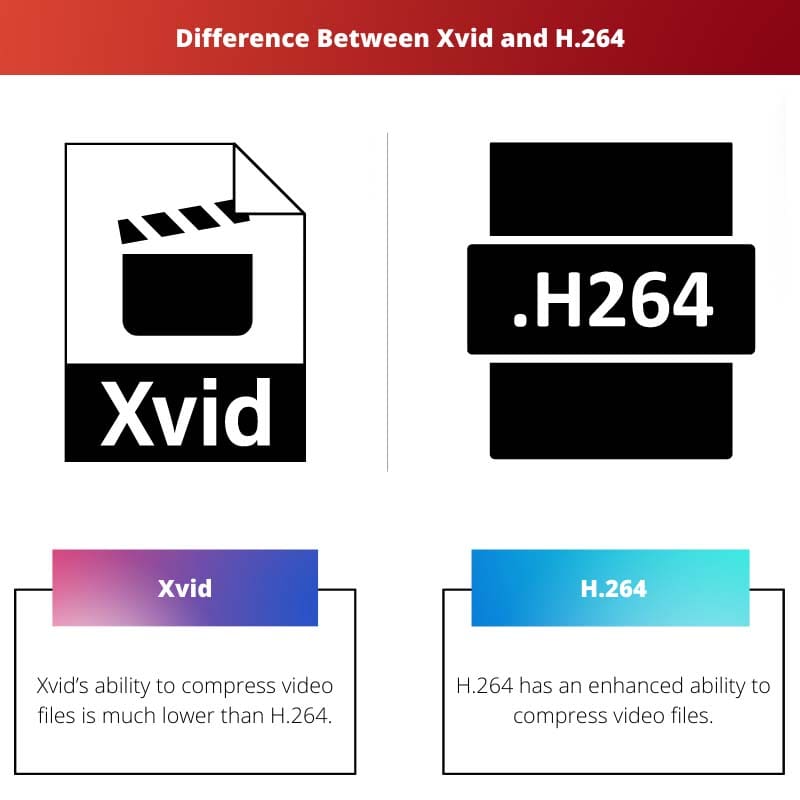The superior compressive strength of H.264 allows the user to significantly reduce the size of a video file by 80% without compromising its quality.
Sometimes the codec also improves the quality of the video file by compressing it. Conversely, the Xvid codec also compresses a video file’s size but cannot reduce its size as significantly as the H.264 codec.
The quality of the compressed files also tends to be inferior to those compressed with the H.264 codec.
Key Takeaways
- Xvid and H.264 are video compression standards used to reduce the file size of video content.
- Xvid is an older standard largely replaced by H.264, which offers better compression and higher video quality at lower bit rates.
- H.264 is widely used in video streaming services, while Xvid is still used in some older video codecs.
Xvid vs H.264
The difference between Xvid and H.264 is that while the H.264 codec has an augmented ability to compress video files, Xvid’s ability to compress video files is much lower. Although both Xvid and H.264 are lossy video compression codecs, their ability to compress data is quite different.

Comparison Table
| Parameters of Comparison | Xvid | H.264 |
|---|---|---|
| Compression Ability | Xvid’s ability to compress video files is much lower than H.264. | H.264 has an enhanced ability to compress video files. |
| Quality | The quality of the compressed file may be compromised. | The quality of the compressed file is not compromised. |
| Encoding Speed | Xvid can be encoded at a relatively higher speed than H.264. | H.264 needs a longer time to be encoded. |
| Decoding Ability | Most devices cannot decode the Xvid codec. | Most devices can decode the H.264 codec. |
| Processing Power Requirements | The processing power requirements are not that high. | The processing power requirements are much higher. |
| Quad Processor | Quad processors are not needed. Xvid also works well with weaker processors. | Quad processors are needed to provide the extra processing power to encode and decode files. |
| Compatibility | The Xvid codec is most compatible with older devices. | The H.264 codec is compatible with most modern devices. |
What is Xvid?
Xvid is a well-known open-source codec, initially released in 2001. Originally it was developed as an outgrowth of the DivX codec.
Xvid has reigned supreme in the lossy compression codec arena for quite a long time. As an alternative codec library, Xvid follows the MPEG4 standard.
Its reputation had surpassed the popularity of the DivX codec.
It was hailed for its ability to encode and decode video files even on weaker processors. Moreover, the Xvid codec allows users to encode and decode files at a relatively enhanced speed level.
Older players are more attuned to the Xvid video codec. This reduces its usability in the modern age.
However, a significant drawback of the format was that sometimes it severely compromised the quality of the compressed video file.
This deterred users from extensively implementing it and fueled the search for an improved version.
What is H.264?
H.264 is one of the most popular lossy video compression formats available.
Initially, the codec was released in 2003 due to a joint endeavour between ITU-T’s Video Coding Experts Group and the ISO/IEC Moving Picture Experts Group (MPEG).
It subsequently gained acclaim for its efficient compressing abilities that reduced the size of the video file by 80% without affecting the quality of the final output.
The only downside with this advanced codec is that its algorithm requires a lot of processing power and time to encode files. Initially, the H.264 codec was also used to compress Blu-ray discs.
Users with weaker processors may not find this codec very useful. Quad processors are best suited for using the H.264 codec.
This high-quality codec is compatible with mobile phones and other digital video players.
Main Differences Between Xvid and H.264
- The main difference between Xvid and H.264 is that H.264 has a significantly better compressive ability than Xvid. It can create smaller video files without compromising the quality of the visual and audio outputs. However, the Xvid codec cannot reduce the video file size as much as the H.264 codec.
- Device manufacturers do not always support Xvid due to its tainted reputation of being used extensively by video piracy conglomerates. On the other hand, H.264 is the standard format used by most devices. Thus, the two differ in the devices and platforms that support each.
- The processing power needed to encode or decode an H.264 file is much higher. Its superior compression ability is accompanied by an amplified processing power requirement much higher than the Xvid codec’s power requirement.
- H.264 offers better quality output than Xvid. The H.264 codec compresses video files without compromising their output quality.
- Xvid can be encoded within a shorter period. Conversely, H.264 takes much longer to encode. This is H.264 codec’s most significant and only conspicuous drawback.
- Quad processors may be the most befitting processors to run the H.264 codec, as they can easily supply the excess power needed. While the Xvid codec works quite well on devices with weaker processors.

- https://ieeexplore.ieee.org/abstract/document/4604423/
- https://www.diva-portal.org/smash/record.jsf?pid=diva2:830797

It’s fascinating to see the evolution of video compression standards. The comparison between Xvid and H.264 provides valuable insights into technological advancements.
The contrasting features of Xvid and H.264 provide an interesting perspective on the trade-offs involved in video compression solutions.
Absolutely, the nuances in capabilities and limitations of each codec offer valuable insights for video content creators and distributors.
The evolving landscape of video compression standards demands a nuanced understanding of the strengths and weaknesses inherent in Xvid and H.264.
The shift from Xvid to H.264 represents a significant transition in the video compression landscape, showcasing the technological advancements in this field.
Indeed, the rise of H.264 reflects the demand for higher quality and more efficient video compression methods in the digital age.
The H.264 codec is really a game-changer in compressing video files while maintaining quality. It’s amazing to see how far technology has come!
While H.264 has its advantages, let’s not overlook the positive aspects of Xvid in terms of compatibility with older devices.
I agree, the efficiency of H.264 is impressive and its widespread compatibility makes it a superior option.
The differences in quality and compatibility between Xvid and H.264 reveal the complexities involved in choosing the most suitable codec for specific applications.
Indeed, the context-specific considerations related to video compression emphasize the need for informed decision-making in media production.
Xvid’s ability to work well with weaker processors makes it an appealing option for certain applications despite its limitations.
The debate between Xvid and H.264 underscores the need to balance compression abilities with processing power and compatibility across devices.
Definitely, it’s crucial to weigh the trade-offs and prioritize the most suitable codec based on specific user requirements.
The differences in encoding speed and decoding ability between the two codecs point to diverse considerations for video production workflows.
The processing power requirement of H.264 is quite high in comparison to Xvid. It’s important to consider the practical implications of these differences.
Absolutely, the potential trade-offs between compression and processing power are crucial factors to address when choosing a video compression standard.
The compatibility differences between Xvid and H.264 highlight the importance of considering the intended platforms for video distribution.
Xvid’s historical significance in video compression should not be overlooked, despite the prevalence of H.264 in modern standards.
Absolutely, acknowledging the contributions of past codecs is essential for understanding the evolution of video compression technologies.